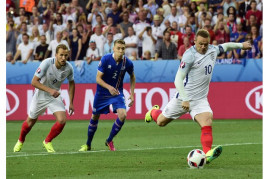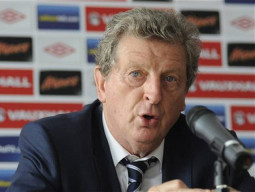
While the rest of the world could not believe what had just unfolded in front of their eyes with England, the traditional heavyweights of world football, knocked out of the Euros by debutants Iceland, it was not all that surprising for the sea of navy blue supporters who, in their hearts, knew they could be a match for any team in the world.
And their confidence, unlike many other emotionally-charged football supporters around the world during such competitions, was not based on sentiment alone; there was a whole decade-and-a-half history behind it.
Football fans mock as England dumped out of Europe twice
Iceland is a small volcanic island-nation with a population of just 325,000. Apart from the four to five-month summer window, the island is covered in ice making it impossible to even carry out mundane activities, let alone get out and play football.
Their season starts from May and ends in September with practically no football for the rest of the year. The players are therefore forced to either play on indoor pitches, or give up the sport entirely in place of other indoor sports.
Naturally, with no place to practice all year round, the footballers from Iceland were unable to compete when pitted against other footballers from Europe.
 PHOTO: AFP
PHOTO: AFPThe Iceland football association (KSI), in its efforts to overcome this hurdle, invested heavily on all-weather pitches and where once only a few training facilities existed 15-20 years ago, there now are 30 full-size all-weather pitches, seven of which are indoors, and almost 150 mini-pitches that ensure players can continue playing football unhampered by the harsh winters of Iceland.
Another factor that curtailed the players’ growth was that there were very few professionally trained coaches available at the grass root level with usually one of the fathers of some child taking on the coaching duties when the teams played over the weekends.
With such a system in place, professional sportsmen became highly impossible to develop for the Scandinavian nation.
Hodgson quits as England boss after Iceland humiliation
However, the KSI countered this problem by overhauling its system and educating their coaches by sending them to complete UEFA-accredited programmes. Today, Iceland have one of the highest percentage of population with coaching degrees in Europe and the best when compared to established footballing nations such as England, Denmark and Sweden.

The initiative started in 2002 and 14 years down the line the results are there for everyone to see. The Iceland national team is not only challenging for major honours, it has managed to develop outstanding footballers such as Gylfi Sigurdsson, Hermann Hreidarsson, Kolbeinn Sigþorsson and Aron Einar Gunnarsson among others.
So what can Pakistan learn from this footballing revolution of the small Scandinavian nation? Well, the first lesson should be that every problem has a solution, if and only if, it is sought persistently and whole-heartedly.
Sports in Pakistan, whether it be cricket, football, hockey, squash, or any other discipline we can think of, suffer from the basic curse of mismanagement which has plagued the rest of the nation.
 PHOTO: AFP
PHOTO: AFPFederations are least interested in developing their respective sports, while in cases where sportsmen try to pursue their passion utilising their own resources, petty politics, a defining factor of almost all Pakistani boards, ensure that does not happen.
But we are not here to throw more mud at our federations, as if people already haven’t done enough; we are here to try to find a solution and hope that someday Pakistan also emerges as a global sporting giant.
Coming back to the topic, Iceland brought about this revolution based on two crucial factors; firstly, providing training facilities for its players and secondly, educating the ones who are going to train on these facilities.
A similar model has been followed by India in the development of their sports but while our neighbours focus more on the marketing of these sports, Iceland focuses more on grass root development. And history has proven that it is only the latter which serves the long-term purposes well.
Iceland stun England in one of greatest ever shocks
Pakistan already has a lot of facilities with a complete list available on the Pakistan Sports Board website. The condition of those facilities and their reach to the wider audience certainly can be questioned at the moment, but that won’t lead anywhere as infrastructure cannot be upgraded overnight.
What can, however, be done is a concentrated effort on renovating these facilities and introducing programmes to reach to the wider audience but before all that could be accomplished, educating the coaches and trainers must be set as the top-most priority.
Without these educated coaches, these facilities are mere blocks of concrete which will rot with time. But with educated coaches, these facilities can come alive and, hypothetically, be all set to produce the next generation of legends.
A concentrated effort on part of our boards along these lines can vastly improve the dying landscape of sport in the country and looking at the Leicesters and the Icelands of the world, who have shown that with persistent efforts and an iron-clad will anything could be achieved, there is still hope that Pakistan can firstly rise to the levels it once reached in its glorious past and then go even beyond that.












































COMMENTS
Comments are moderated and generally will be posted if they are on-topic and not abusive.
For more information, please see our Comments FAQ